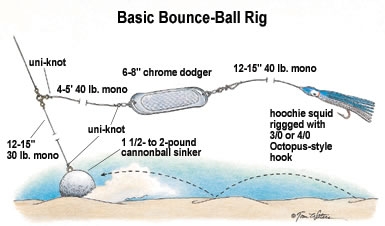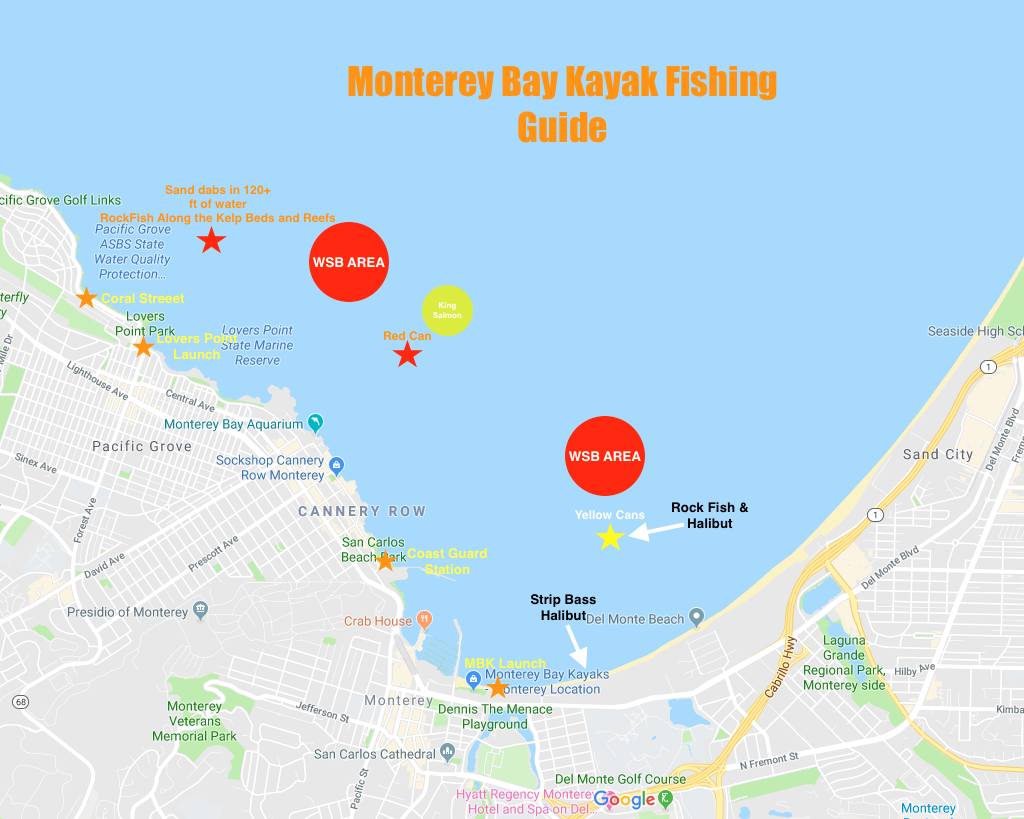Monterey Bay Kayak Fishing Tutorial
Written by The Lost Anchovy 4.2.2019
Introduction
There are few places in the world that can out beat Monterey bay for its beauty and attraction. Monterey began as a small fishing town focused on the large sardine runs that powered the local economy. Although the large sardine runs and fish canning industry have since left Monterey, this city continues to thrive because of the abundant sea life that fuels its economy and the tourism that feeds of it.
For local Northern Kayak Anglers, Monterey bay is the equivalent to the lush beaches and kelp beds of La Jolla, San Diego. The local and migratory fish are abundant as the lush kelp beds that grow along the coastline, and the sea otters that inhabit this area.

The Fishery
Monterey Bay is the most ecologically diverse body of water in all of Northern California. The Bay, when conditions are right, becomes teeming with life from small sardines, anchovies, and squid to larger predatory fish like Salmon and White Sea Bass.
This tutorial will cover methods to catch these fish, starting from smallest to largest. Let’s get started!
Forage fish
- Sardines
- Mackerel
- Anchovies
- JackSmelt
Many people enjoy foraging and eating smaller fish. The most common method to catching forage fish, on a kayak, is with a sabiki lure. Locate the fish with a fish finder or by looking at the surface of the water for teeming fish. Seagulls, pelicans, and sea lions will often be found attacking large shoals of forage fish often giving away their location. Look for these signs and try jigging up some bait with a sabiki lure.
If you plan to use live bait to catch larger fish remember to have a dedicated live well system or a minimum a fabrill bait bucket. Bait fish such as anchovies and sardines are prone to die offs if not provided with aerated water, adequate circulation and space to swim.
On land, if the fish are near the pier, throwing a cast net can be much more effective. Piers such Santa Cruz and Capitola can be ideal locations to cast net when the sardines, anchovies, and mackerel school up over the summer months and are within cast netting distance.
Sand Dabs
Sand Dabs tend to be afterthought for most of the season in Monterey, and are mostly targeted over the winter months in conjunction with coastal crabs. Often Monterey bay charter boats can be found offering crab and san dab combo trips for their customers.
Sand Dabs are found in depths above 120+ and are caught with a Sabiki lure tipped with squid. Honestly, a small hook with tip squid will usually do the trick to catch these small delicate fish.
San Dabs make excellent table fare, and resemble small halibut. These fish can be easily cleaned, gutted and fried (whole) for a tasty treat. They can also be steamed and poached whole for a healthy alternative.
Rock Fish
Rock Fish are plentiful through out Monterey Bay; however, there are MPA (Marine Protected Areas) that anglers should be aware of, such as the Lover’s Point MPA. These areas are restricted fishing boundaries by law.
Rock Fish can be caught using a High-Low rig with shrimp flies and tipped with squid. This is the most common method that people use to catch coastal rockfish.
Tip: If at all possible, try to tie your own rigs. I will help you save money in the long run, and make you a competent fisherman.
Lingcod can be caught using artificial lures such as diamond jigs and swim baits, or by drifting live/dead bait such as sardines, anchovies, smelt and a sex herring. Lingcod are not very particular about their meal source and have been known to bite simply by pure annoyance. They are one of the most aggressive bottom fish in the ocean and it is not uncommon to catch a hitchhiker lingcod when targeting them. They will openly attack other wounded fish looking for a free meal.
How to Catch Coast Rock Fish Tutorial Here
Striped Bass
Stripers routinely cruise the surf line looking for an easy meal over the summer months. Striped bass are a favorite target for the surf cast fisherman using, pile worms, sand crabs, swim baits and buck tails jigs.
The best time to target these fish is early at grey light. My personal preference is to fly line a sardine, anchovy or smelt around a distressed bait ball. The stripers will often be attacking the bait ball from underneath causing commotion that will attract birds and sea lions. Mooching bait outside the surf line can be effective if the fish are around and feeding.
The Lost Anchovy – Kayak Fishing Essential Equipment List
- Shimano TLD 15
- NRS Chinook Personal Flotation Device (Lifevest)
- Shimano Trevala 66MH rod (Universal Rod)
- Fluorocarbon Leader Fishing Line
- Mako Cast Net
- Fisherman’s Game Clip
- gamakatsu “j” hooks
- Big Al Flasher or Kone Zone or Dodger (If Trolling)
- Hoochies (good rated and cheap Amazon hoochies, also try purple haze or white hoochies)
- Three Way Swivels (Impressive reviews on these swivels)
- Dexter Russel Fillet Knife (Best fillet knife IMHO, cheap and works!)
- Foodvac compatible Bags
California Halibut
California Halibut start making their migration into Monterey Bay in early spring and will stay until the fall. Halibut will follow the influx of bait, such as sardines, anchovies, mackerel, and squid. When the large shoals of bait start inhabiting Monterey, it is a good time to start targeting these fish.
Current California regulations allow multiple rods when targeting California halibut in the ocean. There is no seasonal restrictions on halibut, and the daily possession limit is currently three per day.
Department of Fish and game
https://www.dfg.ca.gov/marine/sfmp/halibut-id.asp
Regulations:The recreational fishery for California halibut (Paralichthys californicus) remains open year-round. The daily bag and possession limit is three fish north of Point Sur, Monterey County, and five fish south of Point Sur, Monterey County. The minimum size limit is 22 inches total length. When filleting fish on a vessel south of Point Arena (Mendocino County), the fillet minimum size limit is 16.75 inches in length and the fillet must bear the entire skin intact.
Reference: https://www.wildlife.ca.gov/Fishing/Ocean/Regulations/Fishing-Map/Central#halibut
Coastal halibut are keen to staying near bait, outside reefs, ledges and drop offs. These locations offer them the best chance to ambush forage fish as they swim by or leave the protection of the reef. Target these areas’ drifting live bait such as an anchovy, sardine or a smelt can be productive. Anglers can also drift dead squid, or troll a bounce set up with a hoochie to entice a nice fatty flattie.

How to Catch California Halibut Tutorial Here
King Salmon
The King of the sport-fishing world – The Chinook Salmon can be found roaming the water of Monterey bay through out the summer chasing the shoals of baitfish. Popular places in the Monterey Bay include the Soquel Hole, Soldiers, Pajaro, and the Canyon outside moss landing.
However, closer to Monterey, can be extremely productive when the baitfish shoal up over the summer months. These large bait balls draw in the large predatory fish that will feed on them through out the summer.
Popular locations where King Salmon can be found near Monterey are the red can outside the coast guard station and around lovers point. These areas tend to hold large schools of bait over the summer months that attract the large salmon.
Trolling, mooching or trooching for the King salmon are the popular methods that fisherman use to target Chinook. When targeting King Salmon it is best to fish the outside large bait balls. King Salmon can be found attacking wounded and weak fish outside the large schools looking for an easy meal.
How to fish King Salmon Tutorial Here
TLA Tip: Shine up your bait using the brine method here to catch larger Chinook salmon, Halibut and Lingcod. I use the Salmon University method to brine up sex herring with my own twist.
White Sea Bass
Finally we have arrived at the holy grail of all Northern Californian kayak fisherman’s dreams – The elusive “White Sea Bass”. These large migratory fish are on many kayak anglers “To Catch” list. The urban stories of these large fish taking 200+ ft of line on their initial runs are not myth or fables.
The large migratory WSB are elusive fish that follow migrating and spawning squid. Monterey bay can be a haven for large squid spawns that draw in the large fish.
During years with large upwellings, cold water and nutrient are pulled up from the deep canyons triggering large biomasses of squid into Monterey bay. During full moons the squid school up to spawn and trigger the feeding cycle of the WSB.
Once the squid are done spawning they die and float to the top of the water column leaving behind their bed of eggs. The WSB roam the top looking for an easy meal from the spawned out squid. Fly lining fresh caught squid and frozen squid can get the fish to bite. White Sea Bass are caught at different depths but in Monterey the fish like to bite near the top.
TIP: Using a small sliding sinker with and ¼ or 1/8 ounce weight will help bring the squid below the water and away from marauding seagulls looking for a free meal.
Conclusion
There are few places in the world that can out beat Monterey Bay for its beauty and abundance of wild life. There are few places that I would rather fish. Monterey bay is the jewel of Northern California fishing, and rightly so, is the envy of Kayak Fisherman around the world, and with its abundance of small and large fish, there is always something waiting to be caught for the adventurous fisherman in Monterey Bay. Good luck and tight lines — TLA
Edited 4.2.2019
